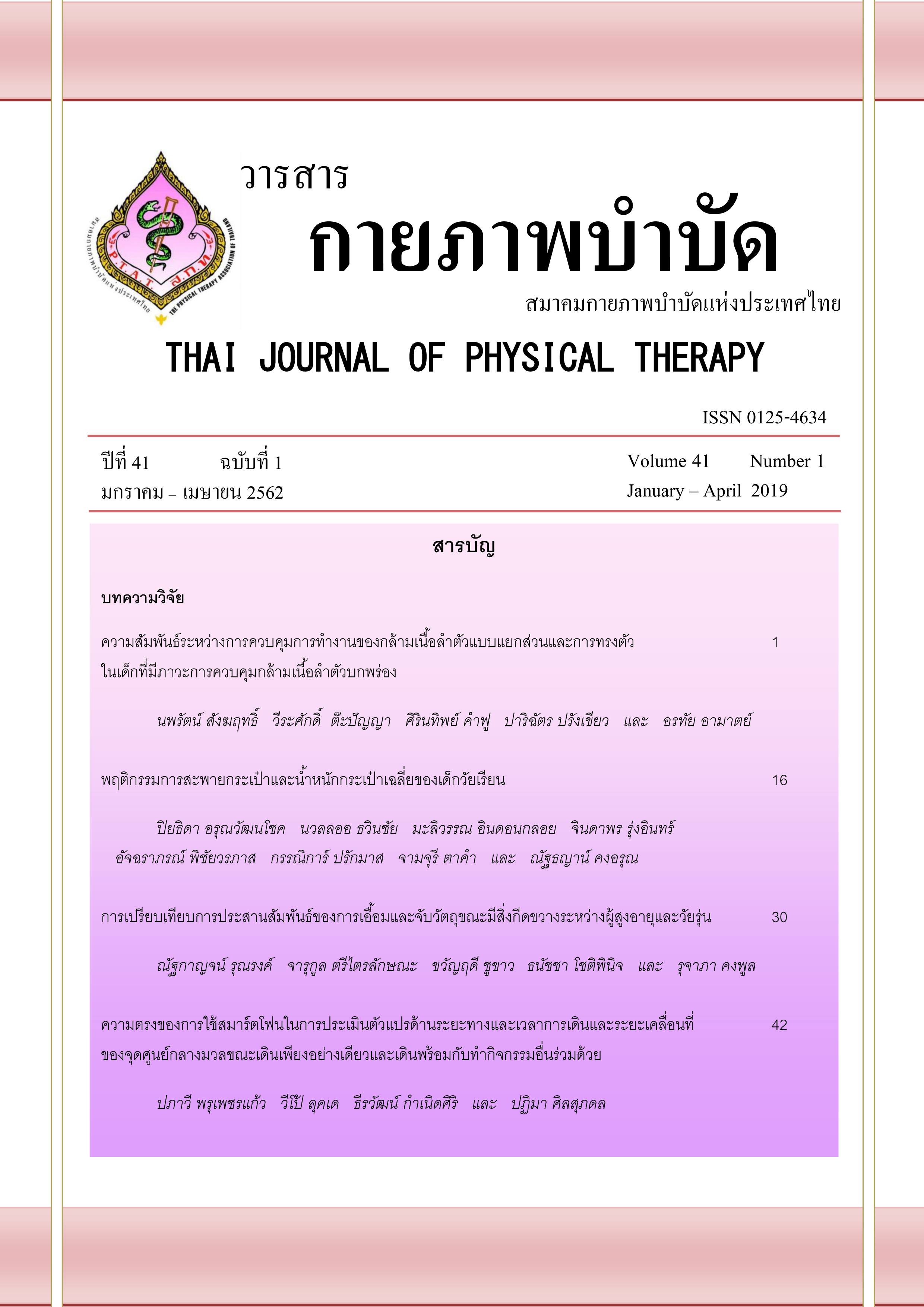การเปรียบเทียบการประสานสัมพันธ์ของการเอื้อมและจับวัตถุขณะมีสิ่งกีดขวางระหว่างผู้สูงอายุและวัยรุ่น
Main Article Content
บทคัดย่อ
ที่มาและความสำคัญ: การเอื้อมและจับวัตถุเป็นการเคลื่อนไหวพื้นฐานที่จำเป็นในชีวิตประจำวัน ซึ่งต้องอาศัยการทำงานประสานสัมพันธ์กัน อย่างไรก็ตามการวิจัยก่อนหน้าพบว่าการประสานสัมพันธ์ของการเอื้อมและจับวัตถุในผู้สูงอายุยังมีความขัดแย้งกัน
วัตถุประสงค์: เพื่อเปรียบเทียบลักษณะการเคลื่อนไหว และการประสานสัมพันธ์ของการเอื้อมและจับวัตถุขณะที่มีสิ่งกีดขวางระหว่างวัยรุ่นและผู้สูงอายุ
วิธีการวิจัย: ผู้เข้าร่วมวิจัยเป็นอาสาสมัครที่ถนัดมือขวา จำนวน 20 คน แบ่งออกเป็นกลุ่มวัยรุ่น (19-22 ปี) และกลุ่มผู้สูงอายุ (61-69 ปี) กลุ่มละ 10 คน ทำการทดลองโดยการเอื้อมมือและจับวัตถุที่อยู่ห่างจากจุดเริ่มต้น 30 เซนติเมตร โดยเคลื่อนไหวให้เร็วที่สุดเท่าที่ทำได้ และไม่ชนสิ่งกีดขวาง ข้อมูลการเคลื่อนไหวทางไคเนมาติกส์ถูกบันทึกด้วยเครื่อง Electromagnetic motion analysis (MotionMonitor) และใช้การวิเคราะห์ข้อมูลแบบสหสัมพันธ์ไขว้ (Cross correlation analysis) เพื่อวิเคราะห์การประสานสัมพันธ์
ผลการวิจัย: ลักษณะการเคลื่อนไหวขององค์ประกอบการเอื้อมที่เกี่ยวข้องทางด้านเวลา (ค่าเวลาที่เกิดความเร็วสูงสุดขณะเอื้อม, 291.67 ±92.51 มิลลิวินาที) และความเร็วในการเอื้อมของกลุ่มผู้สูงอายุช้าลง (ค่าความเร็วสูงสุด, 93.42 ±28.96 เซนติเมตร/วินาที) เมื่อเทียบกับกลุ่มวัยรุ่น (ค่าเวลาที่เกิดความเร็วสูงสุดขณะเอื้อม, 194.20 ±55.83 มิลลิวินาที และค่าความเร็วสูงสุด, 128.80 ±26.87 เซนติเมตร/วินาที; p<0.05) ลักษณะการเคลื่อนไหวขององค์ประกอบการจับที่เกี่ยวข้องทางด้านเวลา (ค่าเวลาที่เกิดการเปิดมือสูงสุด, 516.40 ±154.73 มิลลิวินาที) และการวางแผนการเปิดปิดนิ้วมือในกลุ่มผู้สูงอายุช้าลง (ค่าร้อยละของเวลาที่เกิดการเปิดมือสูงสุด, 73.11 ±5.29%) เมื่อเทียบกับวัยรุ่น (ค่าเวลาที่เกิดการเปิดมือสูงสุด, 330.47 ±80.06 มิลลิวินาที; p<0.01 และ ค่าร้อยละของเวลาที่เกิดการเปิดมือสูงสุด, 67.59 ±6.16%; p<0.05) และกลุ่มผู้สูงอายุมีการทำงานประสานสัมพันธ์ของการเอื้อมมือจับวัตถุทางด้านเวลาลดลง โดยพบว่าช่วงเวลาที่ทำให้เกิดค่าการประสานสัมพันธ์ของการเอื้อมและจับวัตถุนานขึ้น (Tmax, 215.40 ±86.24 มิลลิวินาที) เมื่อเทียบกับกลุ่มวัยรุ่น (Tmax, 98.20 ±36.37 มิลลิวินาที; p<0.01)
สรุปผล: กลุ่มผู้สูงอายุมีความเสื่อมลงของการประสานสัมพันธ์ทางด้านเวลา รวมทั้งลักษณะการเคลื่อนไหวทางด้านเวลาของทั้งการเอื้อมและการจับวัตถุเมื่อเทียบกับกลุ่มวัยรุ่น
Article Details
เอกสารอ้างอิง
2. Shumway-Cook A, Woollacott M. Motor control: theory and practical applications. Baltimore: Williams & Wilkins; 1995.
3. Nicolay CW, Walker AL. Grip strength and endurance: Influences of anthropometric variation, hand dominance, and gender. International Journal of Industrial Ergonomics 2005; 35(7): 605-18.
4. Cole KJ, Rotella DL, Harper JG. Tactile impairments cannot explain the effect of age on a grasp and lift task. Exp Brain Res 1998; 121(3): 263-9.
5. Bennett KM, Castiello U. Reach to grasp: changes with age. J Gerontol 1994; 49(1): 1-7.
6. Bennett KM, Castiello U. Reorganization of prehension components following perturbation of object size. Psychol Aging 1995; 10(2): 204-14.
7. McWhirter T. Effect of aging in reaching and grasping movements: A kinematic analysis of movement context. Ontario, Canada: University of Waterloo; 2011.
8. Tretriluxana J, Gordon J, Winstein CJ. Manual asymmetries in grasp pre-shaping and transport-grasp coordination. Exp Brain Res 2008; 188(2): 305-15.
9. Runnarong N, Tretriluxana J, Hiengkaew V, Vachalathiti R. Reach-to-grasp co-ordination in the paretic limbs of individuals with stroke: insight from a barrier paradigm. J Med Assoc Thai 2014; 97 Suppl 7:S84-88.
10. Marmon AR, Pascoe MA, Schwartz RS, Enoka RM. Association among strength, steadiness and hand function across the adult life span. Med Sci Sports Exerc 2011; 43 (4): 560-7.
11. Grabowski PJ, Mason AH. Age differences in the control of a precision reach to grasp task within a desktop virtual environment. INT J HUM-COMPUT ST 2014; 72(4); 383-92.
12. Cicerale A, Ambron E, Lingnau A, Rumiati RI. A kinematic analysis or age-related changes in grasping to use and grasping to move common objects. Acta Psychologica 2014; 151: 134–42.
13. Wing AM, Turton A, Fraser C. Grasp size and accuracy of approach in reaching. J Motor Behav 1986; 18 (3): 245-60 [Abstract].
14. Yan JH, Thomas JR, Stelmach GE, Thomas KT. Developmental features of rapid aiming arm movements across the lifespan. J Mot Behav 2000; 32(2):121-40.
15. Welford AT. Reaction time, speed of performance, and age. Ann N Y Acad Sci 1988; 515: 1-17.
16. Thelen DG, Muriuki M, James J, Schultz AB, Ashton-Miller JA, Alexander NB. Muscle activities used by young and old adults when stepping to regain balance during a forward fall. J Electromyogr Kinesiol 2000; 10(2): 93-101.
17. Lawrence EL, Dayanidhi S, Fassola I, Requejo P, Leclercq C, Winstein CJ, & Valero-Cuevas FJ. Outcome measures for hand function naturally reveal three latent domains in older adults: strength, coordinated upper extremity function, and sensorimotor processing. Frontiers in aging neuroscience, 2015; 7: 108.
18. Alberts JL, Saling M, Adler CH, Stelmach GE. Disruptions in the reach-to-grasp actions of Parkinson’s patients. Exp Brain Res 2000; 134: 353-62.
19. Khacharoen S, Tretriluxana J, Chaiyawat P, Pisarnpong A. Impaired reach-to-grasp actions during barrier avoidance in individuals with Parkinson’s disease. Journal of the Medical Association of Thailand 2015; 98(9): 889-95.
20. Alberts JL, Saling M, Stelmach GE. Alterations in transport path differentially affect temporal and spatial movement parameters. Exp Brain Res 2002; 143: 417-25.
21. Saling M, Alberts J, Stelmach GE, Bloedel JR. Reach-to-grasp movements during obstacle avoidance. Exp Brain Res 2002; 118: 251-8.
22. Haik MN, Alburquerque-Sendín F, Camargo PR. Reliability and minimal detectable change of 3-dimensional scapular orientation in individuals with and without shoulder impingement. JOSPT 2014; 44(5): 341-9.
23. Wing AM, Turton A, Fraser C. Grasp size and accuracy of approach in reaching. Journal of motor behavior 1986; 18: 245-60.


